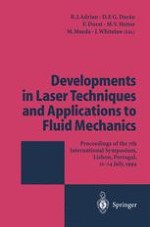1996 | OriginalPaper | Buchkapitel
Characteristics Of Counter — Gradient Heat Transfer In A Non — Premixed Swirling Flame
verfasst von : Y. Hardalupas, M. Tagawa, A. M. K. P. Taylor
Erschienen in: Developments in Laser Techniques and Applications to Fluid Mechanics
Verlag: Springer Berlin Heidelberg
Enthalten in: Professional Book Archive
Aktivieren Sie unsere intelligente Suche, um passende Fachinhalte oder Patente zu finden.
Wählen Sie Textabschnitte aus um mit Künstlicher Intelligenz passenden Patente zu finden. powered by
Markieren Sie Textabschnitte, um KI-gestützt weitere passende Inhalte zu finden. powered by
Measurements of Reynolds shear stress and heat flux, by means of laser Doppler velocimetry and compensated fine wire thermocouples, have been made in the shear layer surrounding a swirl — induced recirculation bubble stabilising an unconfined non-premixed flame. The burner was operated at a Reynolds number of 27000, based on the air bulk velocity of 8.5 m/s and on a characteristic burner exit radius, R, of 50 mm, a swirl number of 1.07 and at a natural gas flow rate corresponding to an equivalence ratio of 0.85 and a potential heat release rate of 50 kW. The sign of the flux of the shear stress was found to be in accordance with that expected from a gradient diffusion hypothesis but the sign of the heat flux was in the counter-gradient direction for axial distances up to 0.5 R from the exit of the quart. Arguments based on the shape of the weighted joint probability distribution of radial velocity and temperature fluctuations, W(v", t") = v" t" P(v", t"), show that the counter-gradient contributions are due to large amplitude, comparatively rare departures of temperature from the local mean and also suggest that the corresponding radial flux of the Favre-averaged conserved scalar, ‹v"ξ"›, will also be in the counter-gradient sense. Even in those regions of the flow where (v" t") is in the gradient sense, the magnitude of W(v", t") in quadrants 2 and 4, which represent counter-gradient flux, remains strong in comparison with quadrants 1 and 3, which represent gradient diffusion. The quantity ‹v"ξ"› is used in the prediction of non-premixed flames and these results show that predictions of this kind of flow must be based on second moment, rather than on effective viscosity, turbulence model closures so as to capture the effects of $$ \bar \xi ''\partial P/\partial{x_i} $$ on heat fluxes.
